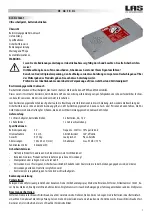
CANplus CP1000
Control Panel Operation Manual
*Patent Pending
23
9M02-1000-A401-EN Revision G
For example, the panel’s Minimum Requested RPM is set to 800 RPM, yet the ECU payload defines the engine
minimum speed to be 900 RPM. In this case, the engine will not run at 800 RPM despite the control panel
requesting a lower engine speed. The ECU will ignore all RPM requests that are below 900 RPM, resulting in a
minimum speed of 900 RPM.
5.2
Ramp Throttle
The standard Ramp Throttle uses the rabbit and turtle buttons to adjust the requested engine or motor speed. All
throttle requests are sent directly to the engine using CAN throttle control or over Modbus to the VFD
Note:
Throttle control requires CAN throttling to be enabled in the ECU. CAN throttling is also known as Torque
Speed Control or TSC1.
When first started, the requested engine or motor speed is Idle RPM.
•
Pressing and releasing the rabbit icon increases the speed by the switch/rotary increment value
(default = 50 RPM)
•
Pressing and holding the rabbit icon causes the speed to increase (ramp) until the maximum
speed is achieved
•
Pressing and releasing the turtle icon decreases the speed by the switch increment value
(default = 50 RPM)
•
Pressing and holding the turtle icon causes the speed to decrease (ramp) until the minimum
speed is achieved
•
The CP1000 will smoothly ramp the RPM up and down using the Max RPM change / s value
(default = 500). This value can be changed in the
Throttle
→
Switch/Rotary
→
Max Change / s
menu.
5.3
Rotary Throttle Control
The optional Digital Rotary Throttle uses a rotary switch to simulate the operation of a throttle. When the engine
or motor is first started, the requested speed is always Idle RPM. Turning the throttle knob clockwise increases
the requested speed by the switch/rotary increment value (default = 10 RPM). Turning the throttle knob
counterclockwise decreases the requested speed.
5.4
Stopping the Engine or Motor
To stop the engine or motor, simply press the “OFF” button. The speed will be reduced in a control fashion and
then the engine or motor will be stopped. Pressing the button for more than 3 seconds will cause the engine or
motor to be stopped immediately. Do not use the Auxiliary Stop (if fitted) or the key switch to stop the engine or
motor under normal conditions.
















































